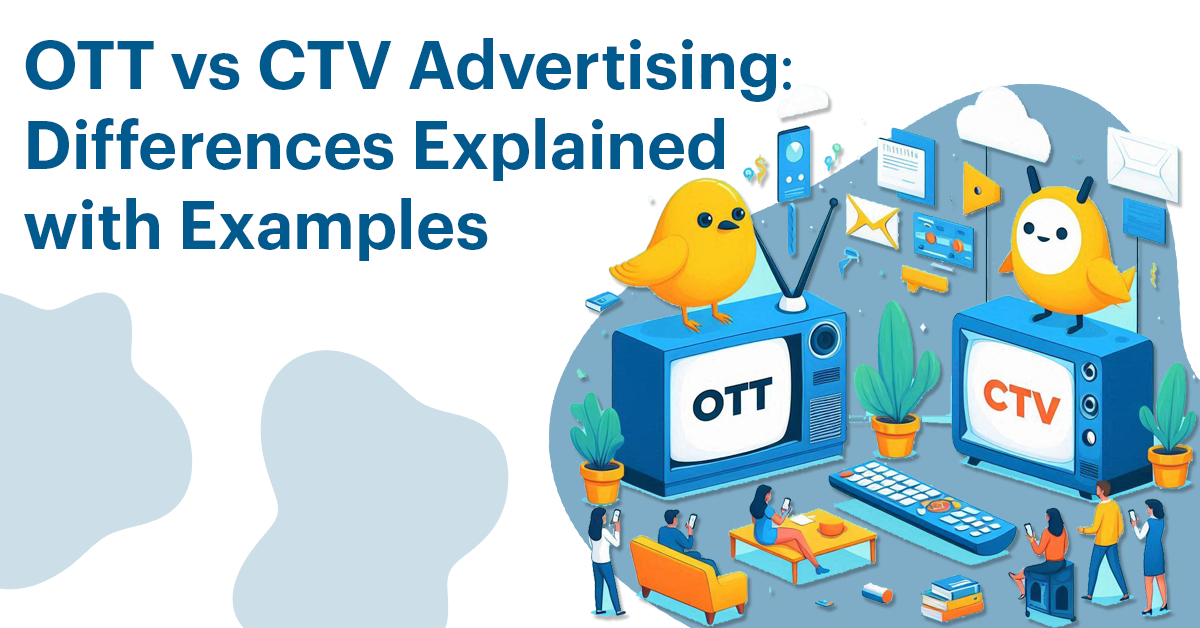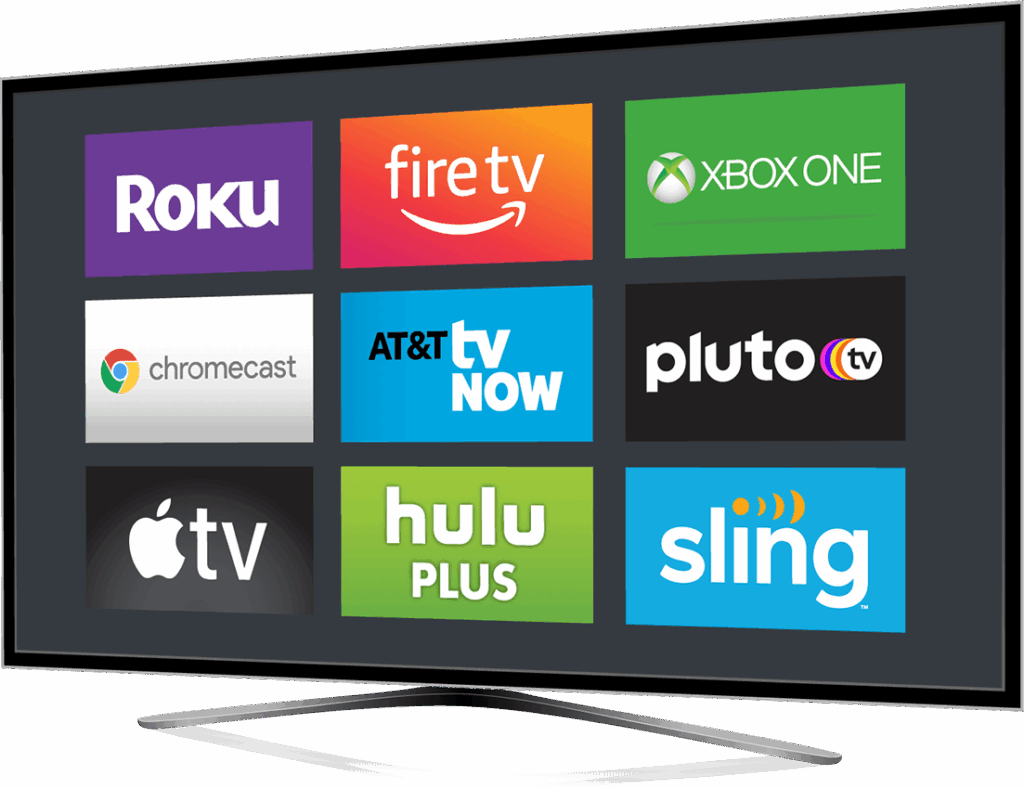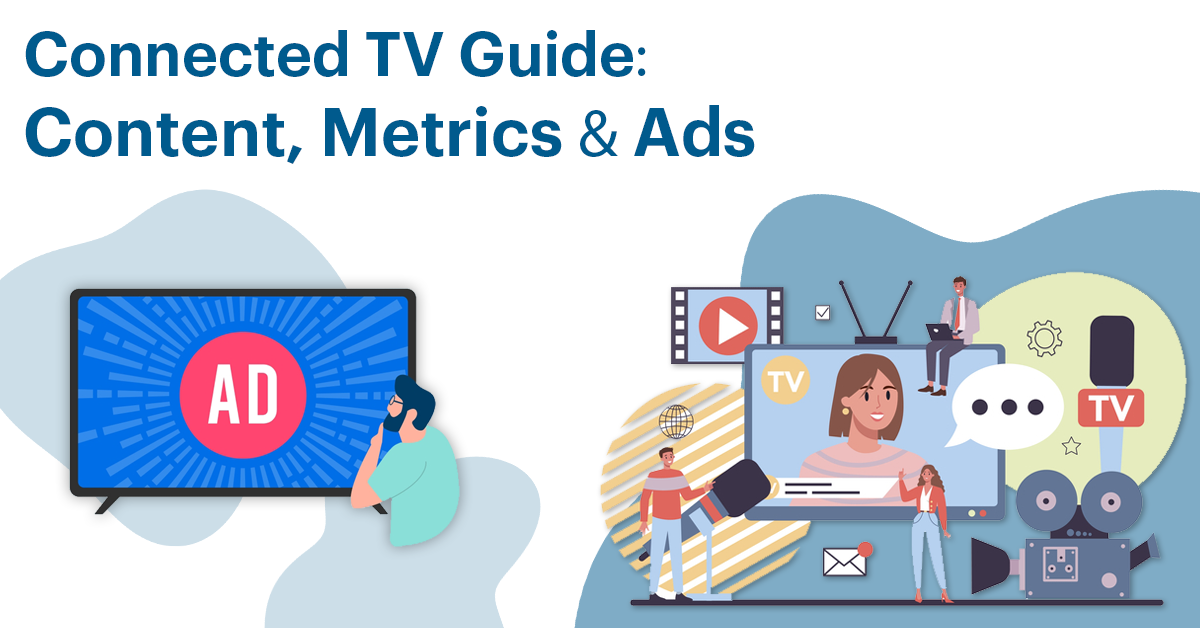OTT vs. CTV Advertising: Differences

People often use Connected TV (CTV) and Over-the-Top (OTT) interchangeably, but they’re not the same. Still, buyers of media must be aware of the distinctions between them when they evaluate advertising placements. Why? The answer lies in being aware of what you’re purchasing.
All CTV content streams digitally, but only a select portion of premium OTT content is actually viewed on connected TVs.
The Core Idea Behind Each Concept Differs.
- OTT delivers videos by streaming them over the internet.
- CTV uses big-screen TVs, such as smart TVs, Roku devices, or Xbox gaming systems, to stream OTT media.
A true CTV campaign starts on the living room TV—not on mobile or tablet streaming like Amazon Prime on-the-go.
In the end, people have more fun when they watch TV shows in their homes, which increases brand recognition with a sense of sound, visuals and motion. Also, we know that viewing with others is a more frequent feature when using television sets. This allows the sharing of experiences to enhance the effectiveness of an ad.
What Is Over-the-Top Advertising?
- OTT advertising is the videos that appear on OTT services, such as Amazon Prime. They can come in a variety of various forms.
- Video ads with pre-roll that start playing prior to the start of a stream on the tablet of a user.
- Advertisements for video mid-roll pop up when you are watching an episode on Hulu in your home.
- Banner advertisements that show static graphics overlays within a YouTube clip.
- The list is endless.
Digital ad broadcasts offer several advantages over traditional TV advertising, including better targeting, real-time insights, and higher audience engagement. Targeting the audience and precise performance measurements, both provide OTT advertising an edge.
However, all of us have switched to a different tab and turned off our laptops during commercial breaks. Imagine clicking the “skip” button on a YouTube ad after five seconds—that’s an example of OTT advertising in action. Here’s a closer look at the differences and examples of each.
There is only one reason for this. OTT adverts that play on devices on the go aren’t the same as CTV ads, which play on the largest screen inside the home.
What Is Connected TV Advertising?
CTV advertising refers to ads displayed to viewers watching their favorite shows and movies on connected TVs. The advantages of CTV in comparison to traditional TV advertisements all go back to the current. CTV advertising provides marketers with deep audience insights and tracks viewer behavior, enabling smarter targeting and better post-ad engagement analysis.

This Permits a Variety of Information-Driven Strategies Such As:
Targeted Precisely: Meet particular demographics, interest groups, and viewing habits.
Placement that is Based on Content: Find your target audience, regardless of the channel they’re listening to, through the placement of ads across an array of publishing companies.
Measure in Real-Time: Record ads’ impressions, clicks and conversions live in real-time.
Retargeting: Re-Engage customers who may have previously interacted with your brand on the internet.
Holistic Attribution: Gain a clear view of how your CTV campaigns contribute to your overall marketing goals.
OTT Advertising Vs. CTV Advertising
We’ve shown how OTT, as well as CTV advertising, allows for higher-tech strategies than placing ads on your grandmother’s cable box.
How Do OTT and CTV Compare in Advertising Performance? In that case, is a video advert that plays on your living room television not that different from those that play on your mobile?
OTT and CTV differ in advertising effectiveness based on the device where the ads appear. Does performance depend on the device used for ad display?
Co-viewing boosts ad impressions, engages active viewers for higher recall, and drives stronger brand impact with measurable business results.
Also, CTV is the creme of the crop of OTT and promises:
More Effective Ad Recall: CTV ads stay at the top of viewers’ minds because they are seen by viewers who are tuned in at the large screen from the comfort of their living spaces.
Engaged Audience: CTV allows advertisers to reach viewers who are relaxed and more receptive to ads than when on mobile devices, often because they’re watching shows they enjoy.
Premium Content: CTV limits content to professional, high-quality, long-form videos from trusted networks.
High Completion Rate: Unlike OTT ads on platforms like YouTube, viewers can’t skip CTV ads, leading to nearly 100% completion rates.
Can Advertisers Merge CTV with Online Video? What Defines OTT?
CTV advertising can be a great way to introduce people to your company’s brand, inform consumers in their area about the latest offer, and reconnect with previous customers by using first-party information. Similar to traditional television advertising, it is the most effective approach to getting your customers’ interest.
However, you don’t have to end there. Since CTV ads run through digital media, you can build powerful retargeting campaigns that combine CTV with online video ads on YouTube and social media.
If, for instance, you expose an individual to a particular brand via CTV, marketers can then retarget the audience with advertisements on websites that encourage more involvement. This approach reinforces your message, guiding viewers through the funnel and boosting conversions in a clickable environment.
Why do we stop here? You can use audio streaming, display ads, and other programming methods to make CTV ads part of an omnichannel marketing strategy.
If you’re planning to combine CTV with paid advertisements to create more comprehensive campaigns, it is important to determine your goals, which are branding exposure or conversion. Building brand awareness is your aim, aim for a 1:1 ratio between CTV ad exposures and retargeting efforts. If your goal is for clicks, fills or phone calls, we suggest a proportion of 1:1.5 (meaning 1.5 retargeting-related impressions per CTV exposure).
Why CTV Represents the Future of TV Advertising
The typical U.S. adult spends more than 123 minutes a day on CTV. Ad-supported streaming has gained mass acceptance, offering premium ad inventory to brands reaching engaged viewers on connected TVs at home.
However, TV advertising can be divided into two distinct groups: linear television and CTV streaming. Advertising has become an arduous task since media buyers have to divide their budgets across different media. In addition, there is the issue of OTT generally, such as streaming audio, online video, and much more media buying, which is now quite overwhelming.
However, we’re heading towards a future of convergence, in which all television is viewed online. By embracing a more consumer-centric model that blends CTV advertising exposure and multichannel content across different channels, advertisers can do well.
Get Started With Strategies
We work with agencies and brands to make CTV advertising easier and boost results. Our ecosystem of partners integrates numerous advertising marketplaces, SSPs, DSPs, data providers and publishers to guarantee precise and targeted ads at the highest level. Our approach is hands-on, offering the knowledge and the resources required to make the most of the investment you make.
Related Articles
Continue your learning journey with these related insights

Connected TV Guide: Content, Metrics and Ads
Connected TV (CTV) is the most rapidly growing major ad network in the US among all types we monitor. CTV is expected to increase by 18.8%, reaching an estimated $28.75 billion by 2025. . Audience segmentation, insight-driven data, screen-based viewing, and interactive features have fueled the rise in CTV’s popularity. Integration with retail and social media […]

Top 6 CTV Advertising Platforms for Publishers
Statista reports that 90% of Internet users watch video every week. Streaming services are one of the more lucrative online publishing business models due to the popularity of this format. You’ll need to have a CTV platform that you can trust, regardless of whether you are a CTV provider already established or just getting started. […]
Ready to Transform Your Advertising Strategy?
Join thousands of advertisers who trust Performoo to optimize their campaigns and maximize revenue.